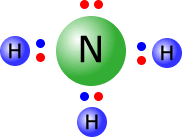|
Although there is no specification to learn industrial processes, they form a link between the theory and the practice and consequently often appear in exams. Manufacturing industry's aim is to make the required products rapidly and efficiently. The principles learned from a study of equilibrium can be applied to some of the most important industrial processes. |

|
The Haber process
Developed by Fritz Haber in the early 20th century, the Haber process is the industrial manufacture of ammonia gas.
The process involves the reaction between nitrogen and hydrogen gases under pressure at moderate temperatures to produce ammonia. However, the reaction is an equilibrium and even under the most favourable conditions, less than 20% of ammonia gas is present.
Haber's adaptation to a well-known reaction, was to recycle the gaseous equilibrium mixture after rapid cooling to remove the ammonia in the liquid form. The conditions for the process demonstrate clearly the principles of equilibrium.
N2(g) + 3H2(g) ![]() 2NH3(g)
2NH3(g)![]() ΔH =
-92 kJ
ΔH =
-92 kJ
Effect of pressure
Pressure conditions: 200 - 250 atmospheres
Inspection of the equilibrium shows that there are four moles of gas on the left hand side to two moles of gas on the right hand side. Therefore an increase in pressure drives the reaction to the side of the ammonia (favourable).
This is in agreement with Le Chatelier's principle, which says that any change in conditions of a system at equilibrium will cause a response which opposes the aforementioned change. Hence, increasing pressure causes the equilibrium to reduce the pressure by moving towards the side of fewer moles of gas.
So why do we not use even greater pressure than 200 - 250 atmospheres? Answer
Greater pressure requires stronger pipelines and more expensive equipment and technology for containment.
Effect of temperature
Temperature conditions: 450ºC
The equation for the reaction is exothermic in the forward direction. Consequently increased temperature favours the reverse reaction. However, at lower temperatures the equilibrium takes too long to establish, so an intermediate temperature of 450ºC is chosen. At this temperature there is about 15% ammonia formed, but it is formed very fast and the mixture recycled.
Removal of liquified ammonia
The key to the Haber process' success is the liquifaction stage, whereby the equilibrium mixture is passed into an expansion chamber where it is cooled rapidly to -70ºC. At this temperature the ammonia liquifies and is tapped off from the bottom of the chamber.
The remaining unreacted gases, now mostly nitrogen and hydrogen, are then pumped round the cycle to mix with more stock gases at the input stage.
As the ammonia has been removed from the right hand side, the gases will then re-establish the equilibrium in the reaction chamber by making more ammonia, and the cycle continues.
Use of an iron catalyst
The iron oxide catalyst does not affect the position of equilibrium, but it does establish the equilibrium more rapidly, allowing lower temperatures to be used.
The contact process
This is the process for the manufacture of sulfuric acid. It replaced the Lead Chamber process.
It is called the contact process for the stage in which the sulfur(IV) oxide and oxygen come into contact with the solid catalyst.
There are three stages:
- Production of sulfur(IV) oxide
- Reaction of sulfur(IV) oxide with oxygen to produce sulfur (VI) oxide
- Absorption of sulfur(VI) oxide in 97% sulfuric acid to form 100% sulfuric acid
|
|
The sulfur(IV) oxide feedstock is obtained by burning sulfur in air.
S(g) + O2(g) → SO2(g)
The sulfur dioxide is then mixed with more air and passed over a vanadium(V) oxide catalyst at about 450ºC and 1-2 atmospheres pressure, when an equilibrium is established forming sulfur(VI) oxide:
2SO2(g) + O2 → 2SO3(g)
The sulfur(VI) oxide is then cooled and absorbed in a 97% sulfuric acid/ 3% water mixture making pure concentrated sulfuric acid.
SO3(g) + H2O(l) → H2SO4(l)
It is not added to water directly because the reaction is very exothermic and would produce a mist of sulfuric acid droplets.
Conditions
The equilibrium for the contact process:
2SO2(g) + O2 ![]() 2SO3(g)
2SO3(g)![]() ΔH = -197 kJ
ΔH = -197 kJ
Suggests that the ideal conditions for sulfur trioxide preparation are low temperatures and high pressures. In the event, high pressures are not needed as the equilibrium is reasonably shifted towards the right hand side (about 98%) under the conditions used.
The vanadium(V) oxide catalyst allows the reactants to establish equilibrium rapidly.

